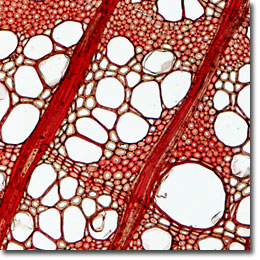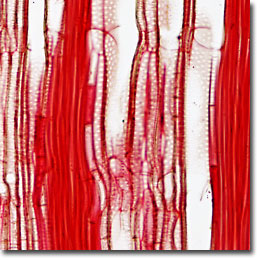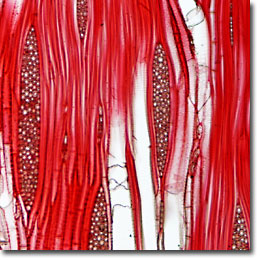The Rock Elm
The Rock Elm (Ulmas thomasii; also known as the Cork Elm) is a hardwood tree that is a native to Canada and the northeastern United States. The rock elm has the hardest and heaviest wood of all the elms, including the European versions. The devastation of most American elm trees due to the Dutch elm disease has rendered the species much too rare for commercial use. Both the sapwood and heartwood are light to dark brown in color.

Cross Section

Radial Section

Tangential Section
A member of the Ulmaceae family containing 18 species, this deciduous tree creates high-branching canopies that offer a significant amount of shade. As a family, elms have alternate, short-stalked leaves that are oblique and double-toothed. The flowers lack petals and the fruit is a compressed nut surrounded by a flat, often hairy wing. Some species are resistant to Dutch elm disease, which has devastated the beautiful American elm (U. americana). Improved cultural conditions can dramatically improve the elm's resistance to this disease.
Elm trees are easily transplanted, and grow in a wide variety of soils with the exception of those that are either very wet or very dry. The trees require full sun for optimal growth rates and survival.
Rock Elm wood is used (although not very often) for boxes, crates, and other containers required to withstand rough handling. It is also used for jobs that demand strength, toughness, and superior bending qualities. Other uses include pallets, veneer for fruit and vegetable containers, cheeseboxes, plywood, furniture, and also for upholstery frames and dinettes, the result of a recent trend calling for "Danish-type" furniture.
Microscopic examination of iron-alum hematoxylin and safranin stained thin sections (see the digital images presented above) reveals ringed porous wood with simple perforation plates. The vessels in late wood are very numerous, and inter-vessel pits range from 8 to 12 micrometers in diameter and are orbicular or angular (through crowding) in shape. Vascular tracheids are present in both the early wood porous zone and in the wavy bands of late wood vessels. Libriform fibers are medium to thick walled, frequently gelatinous, and fine to medium in texture. The rays are unstoried, homocellular, and range from 1 to 10 seriate.